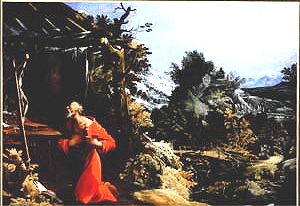 |
|
ST. JEROME IN THE WILDERNESS
Paul Bril Flemish 1554-1626
SN 707 Oil on Canvas About
1595-1600
by Robert Anderson. 2000
ARTIST
Bril was a Flemish landscape painter who studied in Antwerp but
followed his successful brother, Mattheus, to Rome in 1574. His work bridges the gap
between the fantastic 16th century Flemish Manneristic style and the more plausible,
idealized Italian landscapes of the 17th century.
His first works were monumental frescoes and one of his most important
commissions was his fresco cycle depicting hermit saints praying in lush, wooded
landscapes. |
Later in the 1590's Bril began painting small landscapes on panel and
copper, again depicting tempestuous seascapes, hermits in the wilderness, travelling
pilgrims and peasants among ancient ruins.
Bril's style changed in later life from his early Flemish tradition
inaugurated by Pietr Bruegel the Elder which depicted a sense of dramatic motion and
sharply divided light and dark scenes. It became calmer and more classical probably
influenced by Annibale Carracci.
He was renowned throughout Italy particularly for his small easel
paintings and his art influenced the development of future idealized landscape painting in
Italy.
SUBJECT
The subject is the retreat into the wilderness of St. Jerome. After
having been reproached by God in a dream for caring more for the classics that for
Christianity, Jerome resolved to devote his scholarship to the Holy Scriptures. With this
resolve he lived a hermit's life in the wastes of the desert praying, writing and studying
Hebrew, which later enabled him to translate the Bible from Hebrew to Latin.
There is also a story of his having befriended a lion - taking a thorn
from its paw. The lion was said to have then become Jerome's friend and thereafter, when
its image was depicted in art, became a symbol of Jerome.
PAINTING
This painting,done between 1595 and 1600, is an early but by no means
youthful masterpiece. There are influences in this painting of northern Italian landscape
painters who had been in turn influenced by the Flemish Mannerist tradition. The painting
is unusual for this artist whose paintings of this period are generally tempestuous. This
St. Jerome in the Wilderness has a quiet drama, however, that is no less intense.
The nocturnal setting of the scene is an innovation to
a subject which while rare in the North was well established in Italian art of the period.
The moonlit landscape evokes the hermit's isolation from the world with a haunting effect.
Unlike his other landscapes, the figure of St. Jerome in this painting is not an
afterthought but is a key element of the painting. The saint's red mantle rivits the eye
upon him and expresses his religious ardor as he prays before the crucifix.
Dimly visible in the middle distance is the lion who became Jerome's
companion.
HISTORICAL CONTEXT
Saint Jerome was one of the few Fathers of the Church to whom the title
of Saint appears to have been given in recognition of services rendered to the Church
rather than for eminent sanctity. He is the great Christian scholar of his age, rather
than the profound theologian or the wise guide of souls. In controversy he was too fond of
mingling personal abuse with legitimate argument.
|
